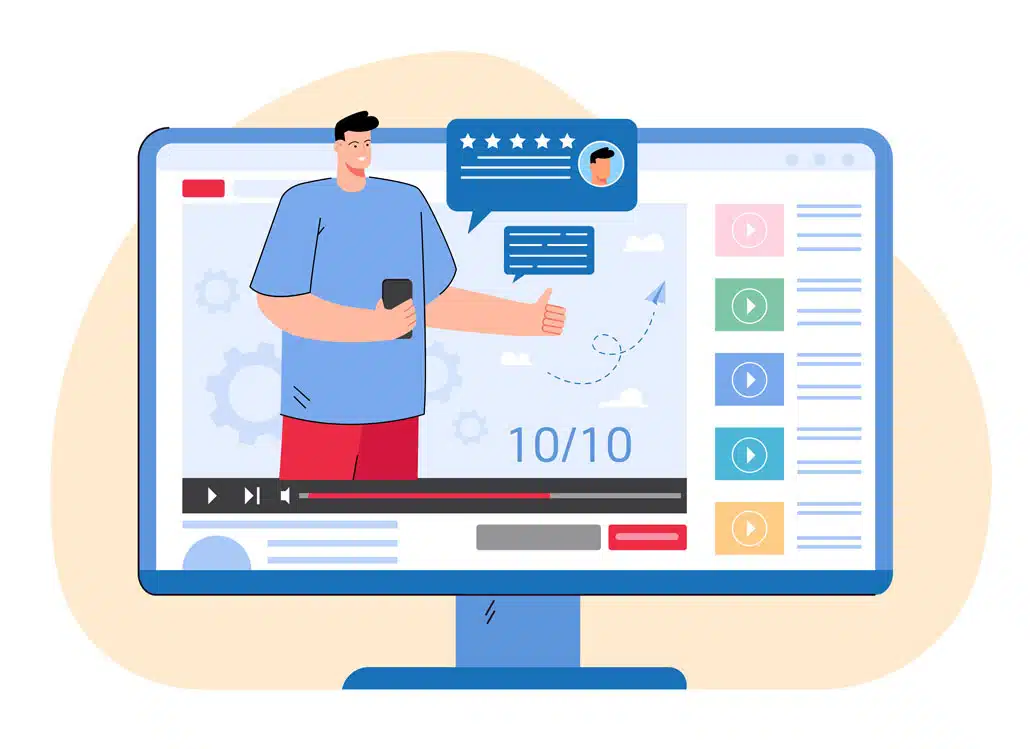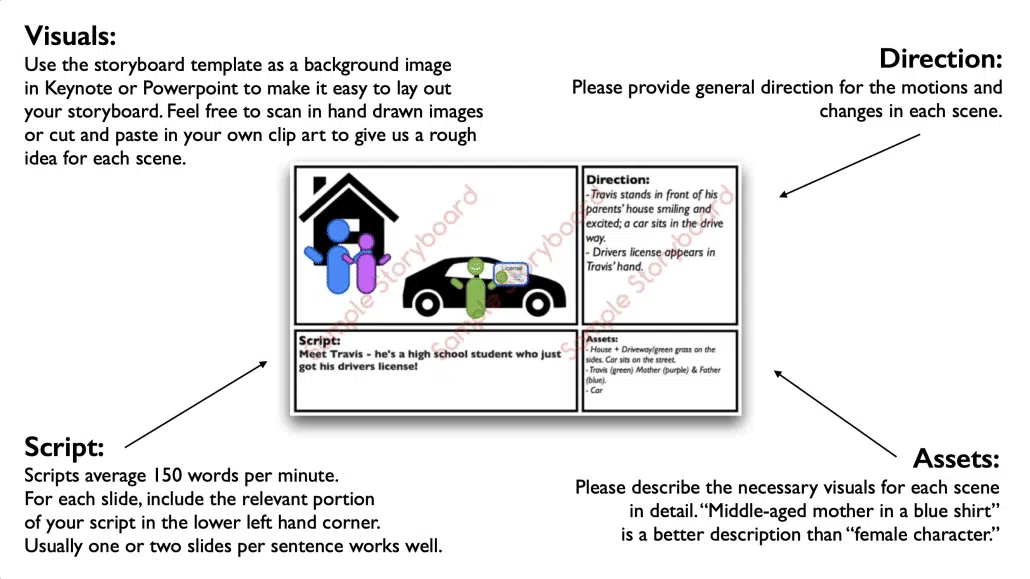How To Make An Animated Advertisement Video
Table of Contents
So you want to know how to make animated advertisement video to promote your product, service or business… but don’t know where to start? This article will provide a high level overview of the process and includes things you should consider along the way when you make animated video ads.
If you have a question about animated video advertisements that isn’t answered in this article, you can use our contact form to ask your question or click the image below to with a member of our production team:
Examples of Animated Advertisement Videos You Can Get From Video Igniter
Video Igniter can create any kind of 2D or 3D animated advertisement for you. Check out our animation portfolio here. Request access to our demo reels and price sheet here. Contact us or to schedule a call start making your video.
Are you looking for an example of a different style of animation? Send us a message to let us know what kind of animation example you want to see and we will follow up with relevant production samples.
Pre-Production: What To Do Before You Make An Animated Advertisement Video

Why Are You Creating An Animated Video Ad?
Before you begin anything – get clear with your team: what is the purpose of this ad? Are you making YouTube animated video ads to reach a specific audience online? Is it to drive your target audience to your website? Generate app downloads? Get people to buy your product? Whatever it is, get clear on that before you do anything so that all creative and budgetary decisions can be in service of that goal.
Identify Your Target Audience & Platforms You Will Advertise On
It’s important to identify the audience your video is speaking to before you begin production so that you can craft the narrative and visuals to speak directly to them. Additionally, identifying your target audience will also determine which platforms you should run your video ads on. Do they use Instagram? Linkedin? Do they watch the evening news on TV?

Knowing which platforms you’ll advertise on will inform what video format to use to reach your audience. This is important know before you begin production. If you were to advertise on Instagram or Snapchat, there’s a good chance you’ll need to make videos instead of horizontal ones.
Find An Animated Ad Video Maker
There are many options to consider here. If you’re looking for professional help, could hire a freelance animator, a full animation studio or Video Igniter to help turn your idea into an animated video ad.
Deep Dive: What should you look for when you want to hire an animator to create a custom animated video?
If you’re looking to save money and make the video ad yourself, you can check out animated video maker services like Vyond, Wideo or PowToon. For a subscription fee, you can get access to their large libraries of images, characters, objects and backgrounds. You then lay out the scenes and create the animated video yourself using simple controls.
To learn more about the pros/cons of choosing different types of animators to help make your animated video ads, check out this companion article titled, “Hiring An Animation Studio vs Freelance Animator vs Marketing Agency vs Marketplace vs Video Igniter”
Production: How To Make An Animated Video Ad
Draft A Script
If you want to create animated video ads, the first step is to draft a script for your animated video(s). Assuming your ad is going to be 30 seconds long, you should aim for roughly 75 words in the script. Be sure to include a compelling hook (introduction), demonstrate the benefits of your product/service, and end the video with a compelling call to action that the viewer can tap on when they watch your video.

Download Video Igniter’s Free Script Writing Template
Consider including notes in your script that explain what is going to be shown visually during each sentence of your script. It can be good to think about the visuals and VoiceOver at the same time to ensure they are optimized to work well together. Don’t want to write the script yourself? You can hire a freelance scriptwriter, an animation studio, or Video Igniter.
Deep Dive: Check out our script writing guide to learn our best practices for creating a high-converting animated video ad.
Create The Storyboard
Making video ads for marketing requires that you create a storyboard before moving into the design and animation phases of production. A storyboard is essentially a blueprint for your animation. It provides instructions for the design team so that they know what images to create and it tells the animators how they are supposed to make the images move in sync with the voiceover.

Download Video Igniter’s Free Storyboard Template
If you don’t want to create the storyboard yourself, freelance animators, animation studios, and Video Igniter are all capable of helping you turn your script into a storyboard.
Resource: Want to save money on your production budget by creating your own storyboard? Check out our storyboard creation guide and get our free downloadable storyboard template.
Soundtrack And VoiceOver
Check out the various stock music websites online to look for background music that will enhance the presentation of your animated ad. Be sure to check out what it costs to license the soundtrack for different platforms and different audience sizes. Depending where you plan to promote your video and how many people you expect to see it, you may need to pay a higher licensing fee for the music.

It’s also important to get the VoiceOver recorded and approved before animation begins so that the animators can use the VoiceOver to sync up the timing of the animation. That’s why it’s a great idea to work on getting the VoiceOver produced while the design team is busy creating art for the animated advertisement.
For more tips on how to get your own professional sounding voiceover produced, check out episode 3 of The Video Igniter Show.
Art Creation
By this point, you’ve probably engaged the services of a talented illustrator or animation studio (or your favorite animated advertising video maker: Video Igniter) to create the art for your animated ad. In most cases, the artist will start by creating some sample concept art for your video – this gives you a chance to share your feedback and refine the visual style to your liking before they spend the time creating all the art for your video ad.

When they send you the full art for your animated video, give it a thorough review with your brand team to ensure the style of the visuals resonates with your target audience and that the visuals do in fact make sense within the context of the accompanying VoiceOver.
Animation
Once your art, VoiceOver and soundtrack have all been approved, your video animator will get to work making the magic happen. Animation typically takes 1-2 weeks for every 60 seconds of 2D animation.

When the first draft of the animated video ad is ready to review, share it with members of your target audience to ensure it resonates with them. If something needs to change because it doesn’t make sense, now’s the time to request simple modifications from your animator.
Deep Dive: Figuring out what kind of animation style is best for your video? Check out our Animation Style Guide: Different Types of Animated Explainer Videos for a pros and cons list of different animation styles.
Run Your Animated Video Ad!
Upload your animated video ad to your ad platforms of choice and measure your results.
Bonus: A/B Test Your Animated Video Ad
It’s worthwhile to A/B test different thumbnails, intros and CTAs in your animated commercials. Consider asking your animator to create a few variations of the intro and ending of your animation so that you can test which version of your video is most likely to convert viewers into customers. That way, after you’ve been running your video campaign for a few months, you can focus your ad spend on the highest performing version of the video.
To learn more about how to get your animated video ads to convert better, check out this companion article.
Animated Advertisement Video FAQ:
How long does it take to make an animated video ad?
A 30-second 2D animation takes about 2-4 weeks to produce. 3D animations can take twice as long. Read more about animation production timelines here.

What does it cost to make an 30 second animated ad?
While you can find low cost options to produce your animation for a few hundred dollars, expect to spend at least $1500-$5000 for a 30 second animated video ad that does a good job highlighting the benefits of your product/service without ruining your brand image.
Where can I advertise my video?
Hulu. Facebook + Instagram. YouTube/Google. Need help navigating all this? Get in touch with us and let us know you’re interested in a video ad campaign.
How do I get the most out of my animated video ad?
Most people just start running their ads to figure out which platforms and demographics convert best. We take things a step farther and can help you test variations of your video to see which brand message converts the most viewers. Check out the video below to learn how you can do it yourself or and we can do it for you.
Deep Dive: Learn about commercial video production.
Incorporating Storytelling in Your Animated Ad

Storytelling in animated ads is an essential strategy for creating emotional connections with your audience. By weaving a compelling narrative, you can make your brand message more memorable, driving greater engagement. Animated ads that tell a story often result in higher recall rates and stronger emotional responses from viewers, which can translate into increased brand loyalty and conversions. Storytelling enables you to take your audience on a journey, creating an experience rather than simply delivering a product or service pitch.
The key elements of a strong animated story involve creating relatable characters, a clear conflict, and a resolution. These components help structure your narrative, making it easier for your audience to follow and understand. The characters should resonate with your target audience, enabling them to see themselves in the story. Whether it’s a hero, a customer, or even a product as a character, creating a persona makes your brand feel human and approachable.
Tailoring your story to your audience is crucial for ensuring relevance. Conduct thorough research to understand the values, pain points, and needs of your target demographic. By aligning your narrative with these insights, you’ll craft a story that speaks directly to your viewers. Whether your audience is looking for humor, inspiration, or problem-solving, your animated ad’s storyline should reflect what matters most to them.
Incorporating visual storytelling techniques like color, animation style, and pacing can significantly enhance the message of your ad. For instance, warm tones and soft lines often evoke a sense of comfort and reliability, while fast-paced movements and bright colors can add excitement and urgency. The visuals should support the storyline, guiding the viewer’s emotions throughout the video. This approach ensures that the animation isn’t just a vehicle for your message but an integral part of the storytelling process.
One of the most powerful aspects of storytelling in animated ads is integrating a call to action (CTA). A strong narrative naturally leads to the desired outcome, such as encouraging viewers to visit your website, make a purchase, or learn more about your product. By building a narrative that flows smoothly into the CTA, you create a compelling reason for viewers to act without feeling forced.
The Impact of Animation in B2B vs. B2C Advertising

Animation plays a distinct role in both B2B and B2C advertising, adapting its style and tone based on the nature of the target audience. For B2B (business-to-business) advertising, animated videos are often used to simplify complex ideas and processes. Many B2B products or services involve intricate details that are difficult to explain through traditional means. Animation, with its ability to visualize abstract concepts and data, makes it easier for business audiences to grasp these ideas quickly and effectively. This is why B2B animated ads often focus on clean, professional visuals that convey clarity and authority.
In contrast, B2C (business-to-consumer) advertising often leans heavily on emotional appeal. Animated ads in B2C campaigns typically aim to entertain, captivate, and create memorable experiences. For example, animated characters, bright colors, and humorous or whimsical elements can make the ad more relatable and shareable. Since B2C consumers tend to be more motivated by emotions, animation in this context aims to build a connection with the viewer that goes beyond the product, focusing on how the brand fits into their lives or enhances their experience.
Understanding audience expectations is critical for creating effective animated ads. B2B audiences generally expect a more professional tone, with animations that demonstrate efficiency and expertise. On the other hand, B2C audiences are more likely to respond to animated ads that are fun, dynamic, and designed to provoke an emotional response. Tailoring the animation style to meet these differing expectations helps brands deliver content that resonates with the right people.
Different animation formats also serve B2B and B2C markets in unique ways. B2B animated ads often utilize educational animations, infographics, and explainer videos to communicate technical aspects of a product or service. Meanwhile, B2C animated advertisements tend to favor more storytelling-driven content, using animations that elicit laughter, surprise, or a sense of wonder. The choice between 2D and 3D animation, character design, and pacing should reflect the nature of the business relationship and the message your brand aims to convey.
Best Practices for Optimizing Animated Ads for Different Platforms

Optimizing animated ads for various platforms ensures that your message reaches the right audience in the best possible format. Each platform has specific requirements for video length, resolution, and format, so tailoring your animated ad for each one is essential for maximizing its effectiveness. For example, social media platforms like Instagram and Facebook tend to favor shorter, snappy videos, typically ranging from 15 to 30 seconds. These platforms prioritize content that grabs attention quickly, so it’s important to make your animated ad visually compelling and easy to understand within a few seconds.
On websites or landing pages, animated advertisements can be longer and more detailed, since users are more likely to engage with content that offers value or provides in-depth information. However, these animations should still be concise and engaging, as website visitors often have short attention spans. Mobile optimization is also crucial, as the majority of web traffic comes from mobile devices. To ensure your animated video advertisement performs well on mobile, keep file sizes small without compromising quality, and ensure that your animations are easy to view on small screens.
When creating animated ads for larger screens like televisions or digital billboards, prioritize high-quality visuals that can capture attention from a distance. These ads often need to be visually striking to stand out in a crowded space. Using bold colors, simple but effective animations, and large, legible text is important for these formats.
Testing and iteration are crucial in optimizing animated ads. A/B testing allows you to experiment with different versions of your animation, adjusting elements such as length, pacing, and call-to-action placement. By analyzing the performance data, you can fine-tune your ads to ensure they resonate with each platform’s audience. Ensuring consistency in your messaging and visual branding is also key, so that regardless of the platform, your animated advertisement reflects the same brand identity.
Using Data to Inform Your Animated Ad Strategy

Data plays a pivotal role in shaping a successful animated video advertisement strategy. By leveraging analytics tools, you can make informed decisions about your animated ad’s content, format, and distribution. Data helps you understand your audience’s preferences, behaviors, and engagement patterns, which in turn enables you to create more targeted and relevant animations. For instance, tools like Google Analytics or Facebook Insights provide valuable information about which types of ads perform best, enabling you to refine your creative approach for better results.
Start by analyzing demographic data to understand the characteristics of your audience. This includes age, gender, location, and interests, all of which influence how they respond to different animation styles and messaging. Use this data to craft animations that resonate with specific segments of your audience. If, for example, you find that your target audience is primarily younger consumers, you may want to incorporate more vibrant colors, humor, and fast-paced animations to align with their preferences.
Using data-driven insights allows for continual optimization of your animated video advertisements. By reviewing performance metrics like click-through rates, engagement rates, and conversions, you can determine which elements of your animation are working and which need improvement. This ongoing process of testing and refining helps you maximize the impact of your animated ads, ensuring that your content remains relevant and effective in achieving business goals.
For example, A/B testing can be particularly useful when comparing two different animated ad variations. You can test different elements, such as the animation style (2D vs. 3D), the length of the video, or the inclusion of certain visual effects or text. Based on which version performs better, you can adapt your strategy to drive more conversions and increase return on investment (ROI).
Measuring the Success of Your Animated Video Ad Campaigns

Measuring the success of your animated video ad campaigns is crucial for understanding their impact and optimizing future efforts. Key performance indicators (KPIs) such as views, click-through rates (CTR), conversion rates, and engagement metrics provide a clear picture of how your ads are performing. By tracking these metrics, you can assess whether your animated video advertisements are meeting their objectives and where improvements can be made.
Engagement metrics, such as likes, shares, comments, and watch time, help you gauge how well your animated ad resonates with your audience. A high level of engagement typically indicates that your animation is capturing the audience’s attention and prompting them to take action, whether that’s sharing the video, visiting your website, or making a purchase. Tracking these metrics across platforms helps you understand which platform is yielding the best results for your ad.
Conversion tracking is another important aspect of measuring success. Whether your goal is to increase sales, drive sign-ups, or boost brand awareness, tracking conversions allows you to see how many viewers are taking the desired action after watching your animated advertisement. Tools like Google Analytics and Facebook Ads Manager provide in-depth insights into user behavior, helping you track the effectiveness of your CTA and overall ad performance.
Additionally, analyzing the performance of your ad on different platforms can offer valuable insights into how to optimize your campaign. For example, you may discover that your animated ad performs better on Instagram Stories than on YouTube. Understanding platform-specific engagement patterns enables you to make data-driven decisions on where to allocate your advertising budget and which formats to prioritize.
How to Budget For The Production Of Your Animated Advertisement Video

Budgeting for animated advertisement production is an essential step to ensure your project runs smoothly without exceeding financial limits. A comprehensive budget should cover all aspects of the animation process, including scripting, storyboarding, animation design, sound, and promotion. Depending on the complexity of your animated advertisement, production costs can vary widely. Simple 2D animations will cost less than more intricate 3D animations, which involve detailed modeling and rendering.
One of the first steps in budgeting is deciding whether to produce the animated ad in-house or hire an animation agency. While agencies often offer professional services, they tend to be more expensive. On the other hand, in-house teams may be more cost-effective but might require specialized skills and software. When choosing between the two options, weigh factors like expertise, time constraints, and available resources to determine the most cost-efficient approach for your brand.
Additionally, don’t forget to allocate part of your budget for marketing and distribution. Even the best animated ad won’t succeed if it’s not properly promoted. Consider the costs of running ads on social media platforms, paying for influencer partnerships, or distributing your video through email campaigns. A well-allocated marketing budget can help ensure that your animation reaches the right audience.
Finally, consider factors like licensing fees, voiceover artists, music, and any third-party services required during production. By including these elements in your budget from the beginning, you can avoid surprises down the line and ensure a smooth production process.
Maximizing Engagement with Interactive Animated Video Ads

Interactive animated video advertisements provide a powerful way to increase engagement by enabling viewers to participate in the ad experience. Unlike traditional ads that are passive, interactive ads encourage viewers to make choices, click buttons, answer questions, or even personalize the content. This level of engagement not only captures attention but also fosters a deeper connection between the viewer and the brand.
There are several types of interactive elements you can include in animated video advertisements. For instance, clickable buttons, quizzes, and polls are great ways to drive user participation. These elements can be tailored to match the viewer’s preferences or behaviors, creating a more personalized experience. Interactive ads also offer the opportunity to gather valuable data about your audience’s interests and preferences, which can be used to refine future campaigns.
Creating a seamless user experience is essential for interactive ads. The interactive elements should enhance the story or message of the animation, rather than distract from it. Viewers should feel that their actions lead naturally to the next part of the ad, whether it’s exploring more product features, discovering offers, or learning about a brand’s values. Properly timed CTAs also help guide the viewer through the interactive experience.
To measure the success of interactive animated video advertisements, track metrics like participation rates, interaction completion, and conversion rates. This data helps you understand how well the interactive elements are resonating with your audience. By continually testing and optimizing your interactive ads, you can refine the experience to maximize engagement and drive results.
How to Avoid Common Mistakes in Animated Ad Production

Creating an effective animated ad requires careful planning and execution. Avoiding common production mistakes can ensure that your ad is both visually appealing and impactful. One of the most frequent mistakes is overcomplicating the animation. While it may be tempting to include as many effects and details as possible, simplicity often works best in animated ads. A cluttered or overly complex animation can confuse viewers and detract from the core message. Focus on delivering a clear, concise story with visual elements that enhance, rather than overwhelm, the viewer.
Another common mistake is failing to understand your target audience. Animated ads need to speak directly to the needs and preferences of your audience. Conduct research to ensure that the animation style, tone, and messaging align with your audience’s expectations. Using the wrong animation style, such as a lighthearted cartoon for a serious business service, can result in a disconnect between the brand and its potential customers.
Ignoring sound design is also a critical mistake in animated ad production. Audio plays a key role in setting the mood and enhancing the visual experience. Poor voiceover quality or mismatched music can detract from the effectiveness of your animation. Ensure that your voiceovers, background music, and sound effects complement the animation, enhancing the emotional impact of the ad.
Failing to test and optimize your animated ad before launching is another common mistake. A/B testing allows you to experiment with different versions of your animation to see which elements work best. By testing different lengths, animation styles, and CTAs, you can fine-tune your ad to maximize engagement and conversions.
Why Hire Video Igniter To Create Your Animated Ad?
Video Igniter creates 2D and 3D animated videos for world class brands like T-Mobile, Amazon Web Services and Snoop Dogg at prices startups can afford.
Here are 20+ reasons companies choose to use Video Igniter when they want to get a custom animated video created.
Check out our portfolio.
Do you want to create an animated cryptocurrency video or an animated blockchain explainer video that explains how your technology works? We can help with that too.
Your production budget is pushed tot he max with Video Igniter. Our online dashboard streamlines your production experience so that your video gets made faster. Additionally, more of your budget is put into creativity and production quality instead of overhead and project management costs.
We’re a global company offering our animated video services to clients around the world, 24/7.
Animated Advertisement Video Success Stories & Testimonials
“I run a video production company and outsource animation. The team at Video Igniter did a great job in taking the concept I very crudely drew out and made it into a beautiful animation. The review process was easy and their turnaround time was very quick. I’d def recommend them if you’re looking for an animation project.”
Pat Henderson – Founder, Path8 Productions
“Video Igniter came to us with a number of creative and engaging ideas and were able to create an exciting, impactful video in a short period of time. And the best part was that it cost much less than other options of similar quality. The video they made is a great marketing tool for us.”
Alex Raymond – Founder, Kapta Systems
“I found exactly what I needed: custom animated production with lots of options, fair price and fast communication. I loved working with the Video Igniter Team. Million thanks.”
Antonina Rome, MD – Bioresona

Conclusion
Now that you know how to make animated advertisement videos, you can create them to help your business stand out and get its message to a wider audience. If you’d like some help creating your animated video ad, schedule a call with our production team.



